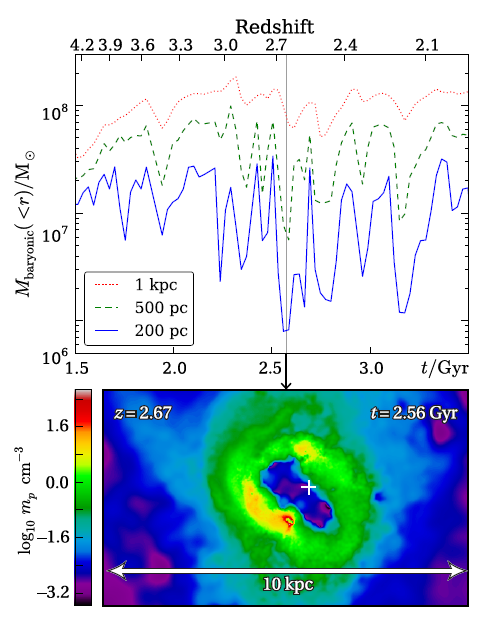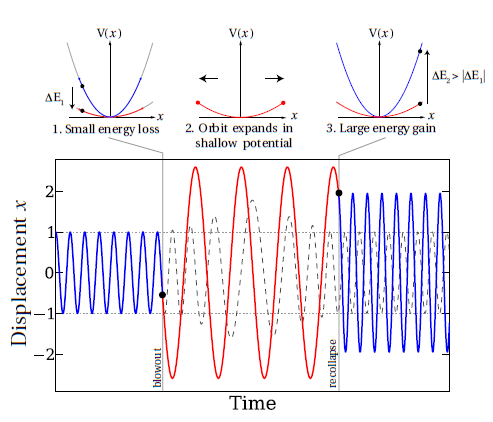
(Main panel) The baryonic mass interior to, from top line to bottom, 1kpc, 500pc and 200pc (HT simulation). Bursty central star formation coupled to strong supernova feedback causes coherent, rapid oscillations in the potential interior to 1kpc. The orbital time of typical dark matter particles interior to 1kpc is & 25Myr. By contrast the simulated supernova bubbles can encompass the inner kiloparsec in around 3Myr, far too rapidly for the adiabatic approximation to be valid. The lower panel shows the disk-plane density during the starburst event at t = 2:56Gyr, z = 2:67. A large underdense bubble has formed at the centre of the disk through thermal expansion of gas heated by multiple supernova explosions. The cross marks the halo
centre.
 The mechanism for injecting energy into the dark matter orbits, illustrated by the exact solution for a time-varying harmonic oscillator potential. The lower panel shows (solid line) a solution to the equations of motion where !2 = 1 (blue) at early and late times, while at intermediate times !2 = 0:1 (red) mimicking baryonic blowout and recondensation. The changes in potential occur instantaneously; in this case the final amplitude of the oscillation is approximately twice that of the initial orbit. The dashed line shows the solution when the potential changes smoothly over several orbital periods; this gives adiabatic behaviour, so that the final orbit regains the initial amplitude, demonstrating the necessity for relatively sudden potential
jumps. The inset figures (top) illustrate how the post-blowout orbit expansion implies that the late-time energy gain dominates over the initial energy loss. We propose and successfully test a novel physical model explaining the origin of cored dark matter density profiles, motivated by recent numerical simulations of dwarf galaxies. In the simulations, the potential in the central kiloparsec repeatedly fluctuates on sub-dynamical timescales over the redshift interval 4 > z > 2 because energetic feedback generates large underdense bubbles from recurrent, centrally-concentrated bursts of star formation. These fluctuations are shown to be responsible for generating a core. Analytic models are presented which describe how particles orbiting in such rapidly fluctuating gravitational potentials gain energy. We proceed from first principles, breaking with a historical reliance on adiabatic approximations which are inappropriate in the rapidly-changing limit. In the new picture, outflows and galactic fountains can both give rise to cusp-flattening. Concentrations of baryons undergoing cycles of rapid expansion and recollapse are the essential ingredient. Constant density dark matter cores should therefore be generated in systems of a wide mass range if central starbursts or AGN phases are sufficiently frequent and energetic. See the webside for more details.http://arxiv.org/abs/1106.0499 (SY) |




